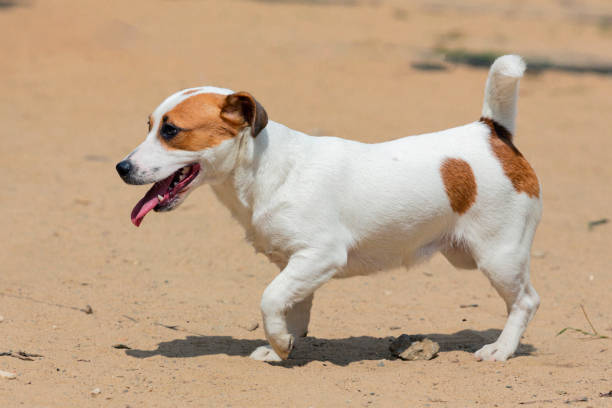Jack Russell Teething and Biting Guide
Welcoming a Jack Russell Terrier into your life can be an exhilarating experience. Their boundless energy, intelligence, and affectionate nature make them cherished companions. However, like all puppies, Jack Russells go through various developmental stages, one of which is teething. In this blog post, we’ll delve into the world of Jack Russell teething and biting, offering insights and guidance to help you navigate this challenging phase of puppyhood.
Understanding and addressing teething and biting behaviors is crucial not only for your Jack Russell’s well-being but also for maintaining a harmonious and enjoyable relationship between you and your furry friend. Teething can be a trying time for both your puppy and you as an owner, as it often comes with discomfort and the natural instinct to bite and chew.
In the sections that follow, we’ll explore the teething process in Jack Russell Terriers, discuss the signs that your pup may be going through this phase, and provide practical strategies for managing teething-related biting. We’ll also introduce you to various teething toys and products designed to soothe your pup’s sore gums and help redirect their biting tendencies. Additionally, we’ll touch on the importance of consulting with a veterinarian during this period to ensure your Jack Russell’s dental health remains in excellent condition.
By the end of this guide, you’ll be better equipped to support your Jack Russell during teething, create a loving and well-behaved canine companion, and navigate the challenges that come with this pivotal stage in their development. So, let’s dive into the world of Jack Russell teething and discover how to make this phase as smooth as possible for both you and your beloved pup.
Understanding Jack Russell Teething

Teething is a natural and necessary part of a puppy’s development, including Jack Russell Terriers. To effectively manage and address your pup’s teething and biting behaviors, it’s essential to understand what your furry friend is going through during this stage.
The Teething Process
Timeline of Teething: Jack Russell Terriers typically begin teething around the age of 3 to 4 months. This process continues until they are approximately 6 to 7 months old when most of their adult teeth have replaced their puppy teeth. It’s important to be aware of this timeline, as it can help you anticipate and manage your pup’s behavior changes.
How Teething Affects Behavior: As your Jack Russell’s baby teeth start to fall out and adult teeth emerge, you may notice several behavioral changes. Teething can be uncomfortable, causing your pup to seek relief through chewing and biting. The discomfort can lead to increased irritability, restlessness, and sometimes even changes in appetite. Understanding that these changes are a natural part of the teething process can help you remain patient and supportive during this time.
Signs of Teething
It’s also crucial to recognize the signs that your Jack Russell is going through the teething phase. These signs can include:
Excessive Drooling: Teething can lead to increased salivation in puppies. If you notice your pup drooling more than usual, it’s likely due to teething.
Chewing and Biting: Your Jack Russell may become more inclined to chew on various objects or even nip at your hands or clothing as a way to relieve the discomfort in their gums.
Swollen or Red Gums: Teething can cause the gums to become swollen and reddened. Check your pup’s mouth for these signs, and if you notice any unusual inflammation or irritation, it’s a strong indicator of teething.
Appetite Changes: Some puppies may experience a temporary decrease in appetite during teething due to the discomfort in their mouths. Keep a close eye on your pup’s eating habits and offer softer or more palatable foods if necessary.
Restlessness: Teething can make your Jack Russell puppy feel restless or agitated. They might have difficulty settling down or seem more fidgety than usual.
Understanding these signs will help you differentiate between typical teething behaviors and other potential health issues. It’s important to remember that while these behaviors can be challenging, they are part of your pup’s natural development, and with the right approach, you can help ease their discomfort and prevent unwanted biting and chewing.
Dealing with Teething Biting

Teething biting is a common behavior in puppies, including Jack Russell Terriers. While it can be frustrating and even painful, it’s crucial to remember that your puppy is not being aggressive; they are merely trying to alleviate the discomfort associated with teething. Here, we’ll provide you with practical tips and techniques for managing and redirecting teething biting behaviors in your Jack Russell.
Tips for Managing Teething Biting
Provide Teething Toys: Offering your pup appropriate teething toys is one of the most effective ways to redirect their chewing and biting instincts. Look for toys designed specifically for teething puppies, as they are often made of soft, rubbery materials that are gentle on their sore gums. Interactive toys that dispense treats can also keep your puppy engaged.
Positive Reinforcement: Use positive reinforcement to encourage good behavior. When your Jack Russell redirects their biting tendencies towards a toy or object, praise and reward them with treats or affection. This helps them associate positive outcomes with appropriate chewing.
Bite Inhibition Training: Teaching your puppy bite inhibition is crucial. This means teaching them to control the force of their bite. When your pup bites too hard during play, let out a high-pitched “yelp” or say “ouch” to imitate the response a littermate would give. This signals to your puppy that they need to be gentler. If they continue to bite too hard, end the play session temporarily. This method teaches your pup to use a softer bite.
Setting Boundaries and Enforcing Rules
Consistent Rules: Establish consistent rules and boundaries from the beginning. Make sure all family members follow the same guidelines to avoid confusion for your pup. For example, if you decide that your Jack Russell is not allowed to bite hands or clothing, everyone in the household should enforce this rule.
Timeouts: If your pup persists in biting during playtime, consider implementing timeouts. Place your pup in a designated “time-out” area, like a puppy playpen, for a brief period. This will help them understand that their biting behavior leads to a loss of playtime.
Avoid Rough Play: While your puppy needs to engage in play and socialize, be cautious about rough play with other dogs or pets. Too much rough play can exacerbate biting tendencies. Ensure that playtime with other dogs is well-monitored and appropriate.
Remember that consistency and patience are key when dealing with teething biting. Your Jack Russell is not trying to be disobedient, but rather, they’re responding to the discomfort of teething. By providing them with suitable outlets for their chewing instincts, using positive reinforcement, and maintaining consistent rules, you can help your pup grow into a well-behaved adult dog while navigating this challenging phase.
Teething Toys and Products

During the teething phase, your Jack Russell Terrier’s gums are sore, and they have a strong urge to chew and bite to relieve the discomfort. To help your pup through this stage and protect your belongings from becoming chew toys, it’s essential to provide appropriate teething toys and products. In this section, we’ll explore various options to soothe your pup’s sore gums and redirect their biting behavior.
Types of Teething Toys and Products:
Chew Toys: Teething-specific chew toys are designed to be gentle on your puppy’s sore gums. Look for toys made from soft, pliable rubber or silicone. These toys allow your pup to chew and gnaw safely, providing relief from teething discomfort.
Frozen Treats: You can create homemade frozen treats to soothe your Jack Russell’s gums. Consider freezing wet washcloths, rubber toys filled with peanut butter or yogurt, or specially designed teething rings. The cold temperature can provide added relief to their inflamed gums.
Rope Toys: Rope toys are great for teething puppies as they allow your pup to chew and play simultaneously. The texture of the rope can massage their gums, making it a popular choice for teething puppies. Ensure that the rope is made of safe materials and inspect it regularly for signs of wear.
Interactive Puzzle Toys: These toys engage your puppy’s mind while offering a chewing outlet. They often have hidden compartments where you can place treats or kibble. Your pup will enjoy the challenge of extracting the goodies and get relief from teething at the same time.
Recommendations for Safe and Appropriate Teething Products:
Choose Safe Materials: When selecting teething toys or products, prioritize those made from non-toxic materials. Read product labels and opt for items designed specifically for teething puppies. Avoid toys with small parts that could be chewed off and swallowed.
Size Matters: Ensure that the teething toys are an appropriate size for your Jack Russell. Toys that are too small may pose a choking hazard, while those that are too large may be challenging for your puppy to manipulate.
Regular Inspection: Regularly check your pup’s teething toys for signs of wear and tear. Replace them if they become damaged to prevent any potential hazards.
Supervision: Always supervise your puppy when they’re playing with teething toys. While these toys are designed with safety in mind, accidents can happen, and you want to ensure your pup doesn’t swallow or choke on any small parts.
By providing your Jack Russell with suitable teething toys and products, you can help them navigate this challenging phase more comfortably and reduce the risk of them chewing on inappropriate items. These toys not only soothe their gums but also offer an outlet for their natural chewing instincts, making teething a less stressful time for both you and your beloved pup.
Tips for Soothing a Teething Jack Russell

Teething can be a trying time for your Jack Russell puppy, and as a responsible owner, there are steps you can take to help ease their discomfort and make the process more bearable. In this section, we’ll explore some simple yet effective tips for soothing your teething Jack Russell.
Ice Cubes and Frozen Treats:
Ice Cubes: Ice cubes are a quick and natural way to numb your pup’s sore gums. Wrap an ice cube in a washcloth and gently rub it on your puppy’s gums. Alternatively, you can place a few ice cubes in a clean sock and let your pup chew on it for a cooling effect.
Frozen Treats: Prepare frozen treats by filling a dog-safe toy or a silicone mold with a mixture of water and low-sodium chicken or beef broth. Freeze it until it’s solid, and then give it to your puppy. The cold treat can provide relief from teething discomfort.
Gentle Gum Massages:
Finger Massages: Wash your hands thoroughly and use your finger to massage your puppy’s gums gently. Apply light pressure in a circular motion. This can help soothe their sore gums and provide a comforting sensation.
Rubber Toothbrush: Some pet stores sell rubber toothbrushes specifically designed for massaging a teething puppy’s gums. These can be effective in providing relief and maintaining good oral hygiene.
Chilled Washcloths:
Soak a clean washcloth in water, wring it out, and then place it in the freezer until it’s cold but not frozen solid. Give it to your Jack Russell to chew on. The texture of the cloth can help massage their gums and provide relief from teething discomfort.
Supervision:
During teething, it’s crucial to supervise your puppy closely, especially when they have access to teething toys or other items to chew on. This ensures their safety and prevents them from accidentally swallowing or choking on small pieces.
Stay Patient and Understanding:
Lastly, remember that teething is a temporary phase in your puppy’s development. Stay patient and understanding, as your Jack Russell may be more irritable or restless during this time. Avoid scolding them for teething behaviors, as this can create negative associations. Instead, use positive reinforcement and redirect their attention to appropriate teething toys.
By implementing these soothing techniques, you can provide your Jack Russell with comfort and relief during the teething phase, making it a more manageable experience for both you and your furry friend.
Common Mistakes to Avoid
Navigating the teething phase with your Jack Russell can be challenging, but it’s essential to be aware of common mistakes that owners often make during this period. By avoiding these pitfalls, you can ensure a smoother and more positive experience for both you and your puppy.
Harsh Discipline
One common mistake is resorting to harsh discipline when your Jack Russell engages in teething behaviors. It’s important to remember that your puppy is not misbehaving out of malice but rather seeking relief from teething discomfort. Yelling, physical punishment, or scolding can lead to fear and anxiety, damaging the trust and bond between you and your pup.
Neglecting Teething Toys
Another mistake is not providing enough appropriate teething toys. Without suitable outlets for chewing and biting, your Jack Russell may resort to chewing on furniture, shoes, or other household items. Ensure your puppy has a variety of teething toys and rotate them to keep their interest.
Inconsistency in Rules
Consistency in rules and boundaries is crucial during the teething phase. If family members have differing expectations or rules regarding your pup’s behavior, it can lead to confusion. Make sure everyone in the household is on the same page when it comes to teething-related guidelines.
Ignoring Dental Health
Teething is a critical time to start paying attention to your Jack Russell’s dental health. Neglecting their dental hygiene can lead to future dental issues. Consider brushing your puppy’s teeth and consulting with your veterinarian about appropriate dental care practices.
Rushing Bite Inhibition Training
Bite inhibition training is a crucial aspect of teaching your pup to control the force of their bite. However, one common mistake is rushing through this training or reacting with excessive pain when your pup nips too hard. This can lead to behavioral problems. Be patient and consistent in teaching your puppy to moderate their bite.
Not Seeking Professional Help When Needed
If your Jack Russell displays severe teething issues or you suspect dental problems, don’t hesitate to consult with a veterinarian or a professional dog trainer. It’s essential to address any potential health concerns promptly and receive guidance on managing challenging behaviors.
By avoiding these common mistakes and maintaining a patient, understanding, and consistent approach, you can effectively guide your Jack Russell through the teething phase while strengthening the bond between you and your furry companion. This phase is temporary, and with the right approach, your pup will grow into a well-behaved and well-adjusted adult dog.
Consultation with a Veterinarian
While most teething-related issues in Jack Russell Terriers can be managed at home with proper care and guidance, there are situations in which it’s essential to consult with a veterinarian. Your puppy’s dental health and overall well-being should be a top priority during the teething phase. In this section, we’ll discuss when and why you should seek professional assistance.
Timing of Veterinary Consultation:
Persistent Discomfort: If your Jack Russell appears to be in persistent pain or discomfort throughout the teething phase, it’s advisable to consult with a veterinarian. Teething discomfort should gradually improve as your pup’s adult teeth come in. If it doesn’t, it could be indicative of an underlying issue.
Bleeding or Infection: If you notice bleeding or signs of infection around your puppy’s gums or teeth, immediate veterinary attention is required. This could be a sign of a dental problem that needs professional treatment.
Excessive Drooling: While some drooling is normal during teething, excessive drooling that continues beyond the typical timeframe should be investigated by a veterinarian to rule out any issues.
Refusal to Eat: If your Jack Russell refuses to eat for an extended period or you notice a significant decrease in appetite, this could be due to dental pain or complications. A veterinarian can perform a thorough examination to determine the cause.
Potential Dental Issues to Watch For:
Retained Baby Teeth: Sometimes, baby teeth may not fall out as adult teeth come in. This can cause dental problems, including misalignment or discomfort. Your vet can assess whether any retained baby teeth need removal.
Misalignment: Teething can sometimes lead to misalignment issues with your pup’s adult teeth. This could affect their bite and overall dental health. A veterinarian can evaluate and address such problems.
Dental Infections: Infections in the gums or teeth can be painful and harmful to your puppy’s overall health. If you suspect an infection, such as swelling, redness, or discharge around the gums, it’s vital to have it examined by a veterinarian.
Regular Dental Check-Ups:
To maintain your Jack Russell’s dental health as they grow, consider scheduling regular dental check-ups with your veterinarian. Routine examinations can help identify and address potential dental issues before they become severe.
Conclusion
Congratulations! You’ve now completed our comprehensive guide on understanding and managing the teething and biting behaviors in your Jack Russell Terrier. As you’ve learned, the teething phase is a natural and crucial part of your puppy’s development. By following the advice and strategies outlined in this guide, you can navigate this challenging period with confidence and ensure the well-being of your furry companion.






